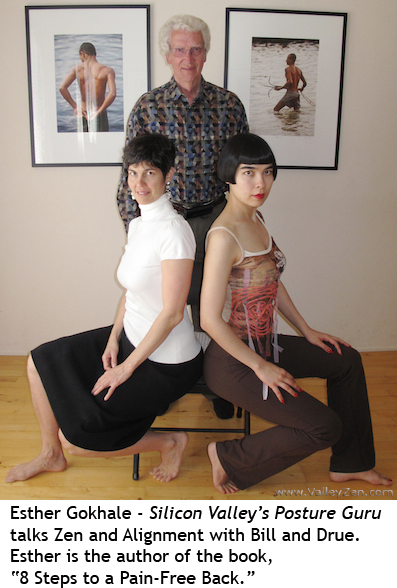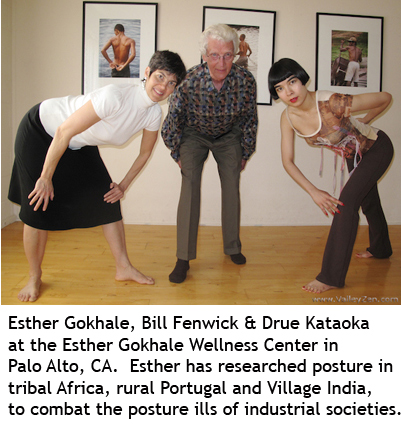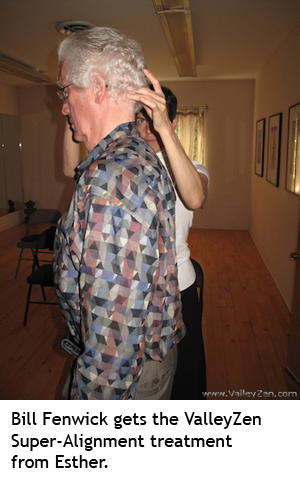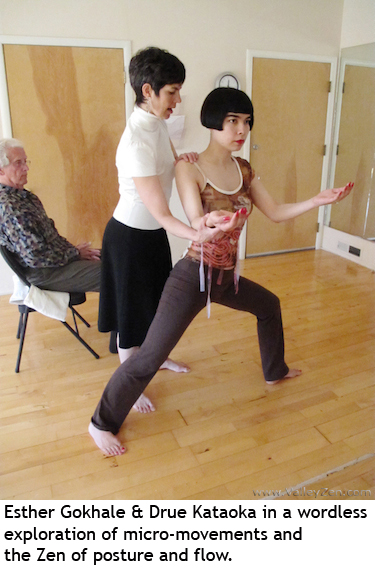The Zen Art of Sitting

Guest Post by Esther Gokhale
Author, 8 Steps to a Pain-Free Back
Whether in Zazen or Valley Zen, sitting is very much a part of our lives. In Zen sitting, each muscle, bone and ligament has a natural place. The design of the skeleton, the end product of millennia of collaboration between gravity and structure, has a natural balance and harmony. When we restore that balance, the result is stillness and flow. No part of the body is pinched or pulled, no part signals the brain that it needs to shift, toss, turn, tighten or be protected. Structure informs function. Blood, lymph, cerebrospinal fluid and Qi circulate unimpeded. A myriad accumulated injuries and rogue events sort themselves out spontaneously.
If this is not the way you currently sit, stillness and poise are still within your reach. Two helpful techniques are stretchsitting and stacksitting. Both transform sitting into a therapeutic activity that will help to heal aching backs and more. Yes, sitting can actually be good for you!
Stretchsitting
(using a backrest to put your back in traction)
Sit well back in your chair.
Curve your body forward from the waist so as to elongate your low back.
Elongate your spine further by pushing against the chair seat with your arms.

Press your elongated spine against the backrest (you may need to modify the backrest with a towel or our newly developed Stretchsit™ cushion.
Let go of all your lengthening efforts, while your spine remains attached to the backrest. Enjoy the stretch in your back while you work, drive, eat, or relax at home.
Stacksitting
This technique is useful when there is no backrest available. The idea is to stack the bones of your spine, from top to bottom, in a single column so that they support your head without any muscular involvement at all. None, zero, zilch. You will find yourself suspended in space and time. Use a small wedge (folded towel or blanket) on the back of the seat. Sit on the edge of the wedge so your pelvis tips forward. Notice that the rest of your spine stacks more easily. If necessary, use some of your abdominal muscles to improve your alignment . If you are swayed, rotate your rib cage forward to straighten out your sway. If your torso needs more length, engage the abdominal muscles that will create extra length)

Your shoulders
Now give attention to your shoulders. They should naturally sit back, so that the arms hang down at the back of the rib cage. One at a time, roll the shoulders forward, up and back in a slow, deliberate circle. Then let your shoulders settle in a position that lets the arm hang further back than before.
Do you feel your chest expand, and breathing become easier? Good, you’ve got it.
Your head
Elongate your neck by gently pulling a clump of hair on the back of your head up and back. Now notice where your head is. It should perch on the top of the spine, chin down, back of the head seeming to rise up the back. When you position it there do you feel the neck muscles release? If so, then, again, you’ve got it.
Finally, just enjoy the sensations traveling through the body as you sit—in a way nature intended, in a moment of Zen.
Esther Gokhale (go-clay), the author of this post, graduated from Princeton with a degree in biochemistry and earned her C.A. from the San Francisco College of Acupuncture and Oriental Medicine. After personal struggles with back pain, unsuccessful back surgery, and a dismal prognosis, she began what would become a lifelong dedication to understanding and addressing the root causes of pain.  Her technique is now detailed in her first book, ‘8 Steps to a Pain-Free Back’. Esther is the founder of the Esther Gokhale Wellness Center in Palo Alto which provides weekly classes in posture & alignment, dance, fitness and yoga. She is the creator of the Gokhale Method and the Stretchsit™ cushion.
Her technique is now detailed in her first book, ‘8 Steps to a Pain-Free Back’. Esther is the founder of the Esther Gokhale Wellness Center in Palo Alto which provides weekly classes in posture & alignment, dance, fitness and yoga. She is the creator of the Gokhale Method and the Stretchsit™ cushion.



An enlightening article for a big chunk of Silicon Valley who have some sort of back problems. I have two questions:
1) I have a chronic hip joint injury, and I am afraid that the stacksitting as described may put extra pressure on my hip joints. Should I be concerned?
2) How do you apply these principles in standing position